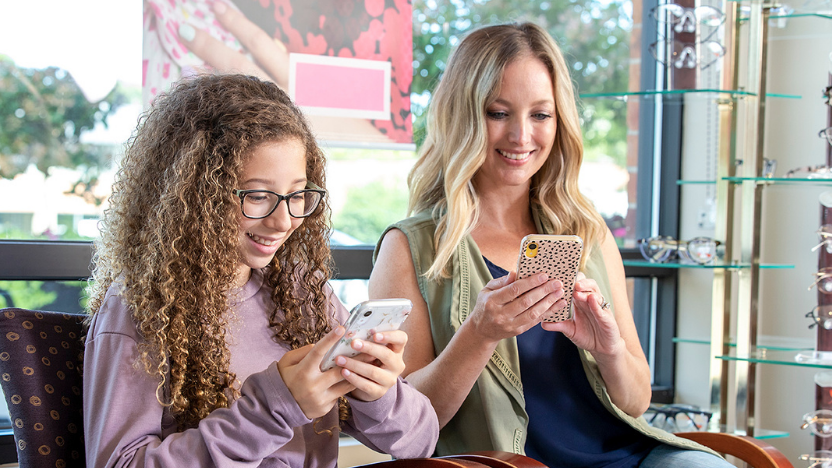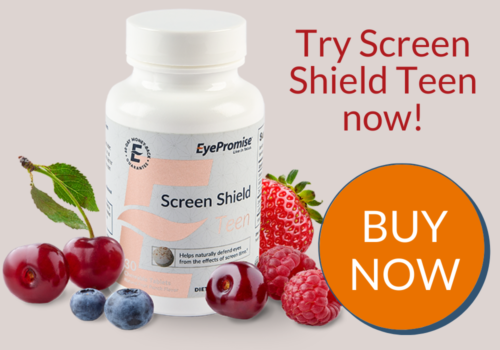What to Know About Screen Time & Eye Health
Posted by amess on Mar 11th 2021
There’s been a lot of talk about the overall increase in screen time over the last year. Many are concerned about its effects on our health – whether it’s related to our sleep, brain, eyes, or overall health. What’s even more concerning is the unknown “long-term” effects that we may not know about yet. While we can’t be sure of the impact screens can have in the future, here’s what you need to know about screen time and eye health now.
How Does Screen Time Affect My Eyes?
Digital screens have been linked to several different eye-related symptoms, including fatigue, strain, blurred vision, dryness, redness, and burning. There are a few different attributes that are blamed for these symptoms.
Blue Light
This has become quite the buzz word when it comes to screen time. However, the popularity growth is for good reason. Blue light is the type of light emitted by digital screens, and this type of light wavelength has more energy than the rest of the visible light scale. Blue light is also emitted by the sun, and this type of high-energy light tends to scatter and spread more easily, which is what gives the sky its blue color during a bright, cloudless day.
Unfortunately, the fact that it scatters more easily also makes it more difficult for our eyes to focus on, so our eyes have to work harder to focus on screens. The longer we look at screens, the longer our eyes are working overtime. All this extra work is thought to lead our eyes to feeling tired and strained after those long hours of screen time.
Natural Blue Light Protection
While screens are a relatively new source of blue light for our eyes to deal with, the sun has been emitting this type of light for thousands of years. Our eyes have actually developed a natural barrier that function like internal sunglasses™ and block this potentially dangerous blue light, but it needs to be sustained through diet and nutrition. The two antioxidants that make up this barrier are called zeaxanthin (zee-uh-zan-thin) and lutein (loo-teen), and it takes at least 8 mg of zeaxanthin to increase your internal blue light protection. That equals 20 ears of corn a day!
Blinking
When we use screens, it can feel like we’re blinking a “normal” amount. In reality, we actually blink about 50% less when we’re using devices, and our individual blinks are even affected. Yes, you read that right. Our blinks decline in quality as well as quantity when using screens, meaning that we don’t fully close our eyes while blinking. This means that our eyes are being deprived of the essential lubrication provided by our eye lids when we blink.
Think of the surface of your eyes like a windshield, your eye lids are the wipers, and the tear film is the wiper fluid. In order to see clearly through the glass, you need to clear off any “impurities” using the wipers and fluid. But if your wipers are stopping halfway, they’re not delivering that wiper fluid to the whole windshield, leaving gaps of the glass that remain dirty and dry. This is what’s thought to cause the dryness, redness, and burning that many people experience with screen time.
Focus

Blurred vision is a symptom that could be caused by several different things. When it comes to screen time, experts believe that blurred vision is partially caused by the need for nearsighted focus. This means we’re focusing on something that’s very close to our eyes for a long time, and our eyes don’t need to adjust for further items. So, when we finally need to adjust our focus to something in our mid- or far-field of vision, it takes our eyes a few seconds to work out the muscles needs to do so. This hesitation is what leads to blurred vision.
How Can I Protect My Eyes From Screen Time?
One way to protect your eyes is by blocking the amount of blue light that enters your retina, limiting the impact it has on your eyes. One common solution is blue light glasses or filters that go on prescription glasses, and while this is a great short-term solution, it can be tough to remember or want to wear them as often as you should. Additionally, the dryness and burning are still an issue.
EyePromise Screen Shield
As we mentioned, you also have natural blue light protection, but you’ll need to strengthen and sustain it through nutrition. Now, there’s an easy, one-a-day answer to your screen time issues. EyePromise® Screen Shield™ is a line of vitamins that deliver high-quality, natural ingredients designed to relieve associated screen time symptoms. This line includes a formula for adults as well as a chewable for children, and both are safe to take alongside a multi-vitamin.
Screen Shield Pro
EyePromise Screen Shield Pro is formulated for adults 18 years and older and includes ingredients like dietary zeaxanthin and lutein to build your internal blue light protection. It also includes highly potent Omega-3s and Vitamin A, two nutrients shown to improve and support a healthy tear film. The full formula also includes essential vitamins and minerals like Vitamin D, CoQ10, alpha lipoic acid, and zinc, building out a well-rounded vitamin for eye and overall health.
Screen Shield Teen
EyePromise Screen Shield Teen is the simplified version of Screen Shield Pro originally designed for children ages 4 to 17. It still has the key blue light-blocking ingredients, zeaxanthin and lutein, but it only includes 3 additional ingredients: Vitamin C, Vitamin E, and zinc. Screen Shield Teen delivers this focused formulation in a fruit punch-flavored chewable, and while it is formulated for children, adults who want to avoid swallowing pills can just up the dosage to 2 tablets a day instead of 1.





